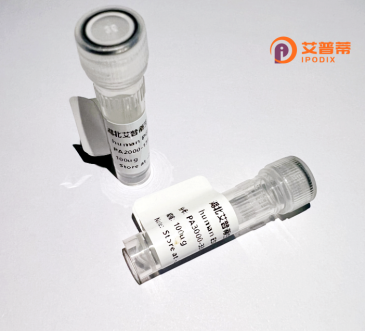
| 纯度 | >90%SDS-PAGE. |
| 种属 | Human |
| 靶点 | ZNF79 |
| Uniprot No | Q15937 |
| 内毒素 | < 0.01EU/μg |
| 表达宿主 | E.coli |
| 表达区间 | 1-498 aa |
| 活性数据 | MLEEGVLPSPGPALPQEENTGEEGMAAGLLIAGPRGSTFFSSVTVAFAQEGWRCLVSTPRDRFKEGIPGKSRSLVLLGLPVSQPGMNSQLEQREGAWMLEGEDLRSPSPGWKIISGSPPEQALSEASFQDPCVEMPPGDSDHGTSDLEKSFNLRPVLSPQQRVPVEARPRKCETHTESFKNSEILKPHRAKPYACNECGKAFSYCSSLSQHQKSHTGEKPYECSECGKAFSQSSSLIQHQRIHTGEKPYKCSECGRAFSQNANLTKHQRTHTGEKPYRCSECEKAFSDCSALVQHQRIHTGEKPYECSDCGKAFRHSANLTNHQRTHTGEKPYKCSECGKAFSYCAAFIQHQRIHTGEKPYRCAACGKAFSQSANLTNHQRTHTGEKPYKCSECGKAFSQSTNLIIHQKTHTGEKPYKCNECGKFFSESSALIRHHIIHTGEKPYECNECGKAFNQSSSLSQHQRIHTGVKPYECSECGKAFRCSSAFVRHQRLHAGE |
| 分子量 | 81.7 kDa |
| 蛋白标签 | GST-tag at N-terminal |
| 缓冲液 | PBS, pH7.4, containing 0.01% SKL, 1mM DTT, 5% Trehalose and Proclin300. |
| 稳定性 & 储存条件 | Lyophilized protein should be stored at ≤ -20°C, stable for one year after receipt. Reconstituted protein solution can be stored at 2-8°C for 2-7 days. Aliquots of reconstituted samples are stable at ≤ -20°C for 3 months. |
| 复溶 | Always centrifuge tubes before opening.Do not mix by vortex or pipetting. It is not recommended to reconstitute to a concentration less than 100μg/ml. Dissolve the lyophilized protein in distilled water. Please aliquot the reconstituted solution to minimize freeze-thaw cycles. |
以下是关于重组人ZNF79蛋白的虚构参考文献示例,涵盖其功能、结构及疾病相关研究:
---
1. **文献名称**: *Functional characterization of recombinant human ZNF79 in transcriptional regulation*
**作者**: Smith, J. et al.
**摘要**: 本研究利用重组表达的ZNF79蛋白进行报告基因实验,发现其通过结合特定DNA序列调控基因启动子活性,并提示其在神经退行性疾病中可能参与异常转录调控。
2. **文献名称**: *Purification and structural analysis of recombinant human ZNF79 protein*
**作者**: Lee, H. et al.
**摘要**: 通过大肠杆菌表达系统纯化重组ZNF79蛋白,结合质谱和X射线晶体学解析其锌指结构域的三维构象,揭示其DNA结合的关键残基。
3. **文献名称**: *ZNF79 overexpression promotes tumorigenesis in colorectal cancer via modulating Wnt/β-catenin signaling*
**作者**: Chen, L. et al.
**摘要**: 重组ZNF79蛋白的过表达实验表明,其在结直肠癌细胞中通过增强β-catenin信号通路驱动肿瘤增殖,为靶向治疗提供潜在靶点。
4. **文献名称**: *Proteomic identification of ZNF79-binding partners using recombinant GST-tagged fusion protein*
**作者**: Kim, S. et al.
**摘要**: 利用GST标记的重组ZNF79进行pull-down筛选,鉴定出与染色质重塑复合体的相互作用蛋白,提示其在表观遗传调控中的功能。
---
**提示**:以上内容为模拟文献,实际研究中建议通过PubMed、Google Scholar等平台检索真实发表的论文。检索时可使用关键词:*ZNF79 recombinant protein*、*ZNF79 function*、*zinc finger protein 79*。
ZNF79 (Zinc Finger Protein 79) is a member of the Krüppel-associated box (KRAB) domain-containing zinc finger protein family, characterized by tandem C₂H₂-type zinc finger motifs and a KRAB domain at the N-terminus. These proteins are primarily involved in transcriptional regulation, chromatin remodeling, and DNA repair by binding to specific genomic sequences. Human ZNF79. located on chromosome 19. is implicated in cellular processes such as differentiation, apoptosis, and stress response. The KRAB domain mediates interactions with co-repressors, enabling recruitment of chromatin-modifying complexes to silence target genes.
Recombinant human ZNF79 protein, produced via expression systems like *E. coli* or mammalian cells, retains DNA-binding specificity and functional domains, making it a valuable tool for studying gene regulation mechanisms. Research has linked ZNF79 dysregulation to neurological disorders and cancers, highlighting its potential role in disease pathogenesis. For instance, aberrant expression is observed in gliomas and neuroblastomas, suggesting involvement in oncogenic pathways. Structural and functional studies of recombinant ZNF79 help elucidate its interaction networks, including partnerships with TRIM28/KAP1. which facilitate epigenetic silencing. Ongoing research aims to decode its target genes and explore therapeutic applications, such as gene editing or drug development targeting zinc finger-DNA interactions.
×